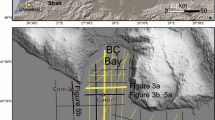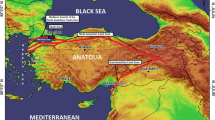Abstract
The Zenisu deep-sea channel originates on the Izu-Ogasawara island arc, and disappears in the Shikoku Basin of the Philippine Sea. The geomorphology, sedimentary processes, and the development of the Zenisu deep-sea channel were investigated on the basis of swath bathymetry, side-scan sonar imagery, submersible observations, and seismic data. The deep-sea channel can be divided into three segments according to the downslope gradient and channel orientation. They are the Zenisu Canyon, the E–W fan channel, and the trough-axis channel. The sediment fill is characterized by turbidite and debrite deposition and blocky–hummocky avalanche deposits on the flanks of the Zenisu Ridge. In the Zenisu Canyon and the Zenisu deep-sea channel, sediment transport by turbidity currents generates sediment waves (dunes) observed during the Shinkai 6500 dive 371. The development of the Zenisu Canyon is controlled by a N–S shear fault, whereas the trough-axis channel is controlled by basin subsidence associated with the Zenisu Ridge. The E–W fan channel was probably affected by the E–W fault and the basement morphology.










Similar content being viewed by others
References
Aoki Y, Tamano T, Kato S (1982) Detailed structure of the Nankai Trough from migrated seismic sections. AAPG Bull 34:308–322
Ashi J, Taira A (1992) Structure of the Nankai accretionary prism as revealed from IZANAGI sidescan imagery and multichannel seismic reflection profiling. Island Arc 1:104–115
Carter RM (1988) The nature and evolution of deep-sea channel system. Basin Res 1:41–54
Chamot-rooke N, Le Pichon X (1989) Zenisu Ridge: mechanical model of formation. Tectonophysics 160:175–193
Clark JD, Pickering KT (1996) Architectural elements and growth patterns of submarine channels: application to hydrocarbon exploration. AAPG Bull 80:194–221
Damuth JR, Flood RG, Kowsmann RO, Belderson RH, Gori M (1988) Anatomy and growth pattern of Amazon deep-sea fan as revealed by long range side-scan sonar and high resolution seismic studies. AAPG Bull 72:885–911
Flood RD, Damuth JE (1987) Quantitative characteristics of sinuous distributary channels on the Amazon deep-sea fan. Geol Soc Am Bull 98:728–738
Henry P, Mazzotti S, Maury R, Robert C, Lallemant SJ (1997) Uplifted oceanic crusts on Zenisu Ridge. JAMSTEC J Deep Sea Res 13:509–520
Kato S, Sato T, Sakurai M (1983) Multi-channel seismic reflection survey in the Nankai, Suruga and Sagami trough. Rep Hydrogr Res Marit Safety Agency Jpn 18:1–23
Kobayashi K, Kasuga S, Okino K (1995) Shikoku basin and its margins. In: Taylor B (ed) Backarc basin: tectonics and magmatism. Plenum, Now York, pp 381–405
Lallemand SE, Malavieille J, Calassou S (1992) Effects of oceanic ridge subduction on accretionary wedges: experimental modeling and marine observations. Tectonics 11:1301–1313
Lallemant S, Chamot-Rooke N, Le Pichon X, Rangin C (1989) Zenisu Ridge: a deep intraoceanic thrust related to subduction, off Southwest Japan. Tectonophysics 160:151–174
Le Pichon X, Iiyama T, Boutegue J, Charvet J, Faure M, Kano K, Lallemant S, Okada H, Rangin C, Taira A, Urabe T, Uyeda S (1987) Nankai Trough and Zenisu Ridge: a deep-sea submersible survey. Earth Planet Sci Lett 87:285–299
Le Pichon X, Kobayashi K, Kaiko-Nankai Scientific Crew (1992) Fluid venting activity within the eastern Nankai Trough accretionary wedge: a summary of the 1989 Kaiko-Nankai results. Earth Planet Sci Lett 109:303–318
Le Pichon X, Lallemant SJ, Thoue H, Huchon P, Henry P (1996) Structure and evolution of the backstop in the eastern Nankai Trough are (Japan): implications for the soon-to-come Tokai earthquake. Island Arc 5:440–454
Lowe DR (1982) Sedimentary gravity flow II: depositional models with special reference to the deposits of high density turbidity currents. J Sedim Petrol 52:279–297
Middleton GV, Hampton MA (1973) Sediment gravity flows: mechanics of flow and deposition. In: Middleton GV, Bouma AM (eds) Turbidites and deepwater sedimentation. Society of economic paleontologists and mineralogists, Los Angeles, pp 1–38
Middleton GV, Hampton MA (1976) Subaqueous sediment transport and deposition by sediment gravity flows. In: Stanleng DJ, Swift DP (eds) Marine sediment transport and environmental management. Wiley, New York, pp 197–218
Mitchum RM (1985) Seismic expression of submarine fans. In: Berg OR, Woolveton DG (eds) Seismic stratigraphy II—an integrated approach. AAPG Mem 39, pp 116–136
Moore GF, Shipley TH, Stoffa PL, Karig DF (1990) Structure of the Nankai Trough accretionary zone from multichannel seismic reflection data. J Geophys Res 95:8753–8765
Nakamura K, Renard V, Angelier J, Azena J, Bourgois J, Depulus C, Fujioka J, Hamano Y, Huchon P, Kinoshita H, Labbaume P, Ogawa Y, Seno T, Takeuchi A, Tanahashi M, Uchiyama A, Vigneresse JL (1987) Oblique and near collision subduction, Sagami and Suruga troughs: preliminary results of the French-Japanese 1984 Kaiko cruise, leg 2. Earth Planet Sci Lett 83:229–242
Nakanishi A, Shiobara H, Hino R, Kodaira S, Kanazawa T, Shimamura H (1998) Detailed subduction structure across the eastern Nankai Trough obtained from ocean bottom seismographic profiles. J Geophys Res 103:27151–27168
Normark WR (1999) Late Pleistocene channel-levee development on Monterey submarine fan, central California. Geo-Mar Lett 18:179–188
Normark WR, Gutmacher CE (1989) Major submarine fans of the California continental rise. In: Winterer EL, Hussong DL, Decker RW (eds) [The Eastern Pacific Ocean and Hawaii. The Geology of Northern America]. Geological Society of America, Boulder, pp 373–382
Okade H, Bukry D (1980) Supplementary modification and introduction of code number to the low-latitude coccolith biostratigraphic zonation (1971, 1975). Mar Micropalaeontol 5:321–325
Olafsson G (1993) Calcareous nannofossil biostratigraphy of the Nankai Trough. In: Hill IA, Taira A, Firth JV et al (eds) Proceedings ODP, Scientific Results 131. College Station
Pickering KT, Underwood MB, Taira A (1993) Open-ocean to trench turbidity-current flow in the Naikai Trough: flow collapse and flow reflection. In: Hill IA, Firth JV et al (eds) Proceedings ODP, Scientific Results 131, College Station, pp 35–43
Reading HG (1996) Sedimentary environments: processes, facies and stratigraphy, 3rd edn. Blackwell, New York, pp 418–446
Segawa J (1998) Tectonics of the offshore Tokai district. Bull Int Ocean Res Develop Tokai Univ 19:93–104
Soh W, Tokuyama H (2002) Rejuvenation of submarine canyon associated with ridge subduction, Tenryu Canyon, off Tokai, central Japan. Mar Geol 187:203–22
Soh W, Nakayawa K, Kimara T (1998) Arc-arc collision in the Izu collision zone, central Japan, deduced from the Ashigara Basin and adjacent Tanzawa Mountains. Island Arc 7:300–341
Taira A, Ashi J (1993) Sedimentary facies evolution of the Nankai forearc and its implications for the growth of the Shimanto accretionary prism. In: Hill I, Taira A, Firth JV et al (eds) Proc ODP, Scientific Results 131. College Station, pp 331–339
Taira A, Niitsuma N (1986) Turbidite sedimentation in the Nankai Trough as interpreted from magnetic fabric, grain size, and detritus model analysis. In: Kagami H, Karig DE, Coulbourn WT et al. (eds) Initial reports DSDP 87. US Government Printing Office, Washington, pp 611–632
Takahashi N, Amano H, Hirata K, Kinoshita H, Lallemant S, Tokuyama H, Yamamoto F, Taira A, Suyehiro K (2002) Faults configuration around the eastern Nankai Trough deduced by multichannel seismic profiling. Mar Geol 187:3–30
Tokuyama H, Ashi J, Soh W, Kuramoto S, Ikeda Y (1998) Active submarine faults off Tokai (in Japanese). University of Tokyo Press, no 151
Wu S, Sakamoto I, Horiuchi S, Misawa Y, Ohta S (2000) Sedimentation and deformation in the adolescent subduction zone, south flank of Zenisu Ridge, northern Philippine Sea, revealed by manned submersible and seismic data. American Geophysical Union 2000 WPG Meet, Trans Am Geophys Union Suppl EOS
Acknowledgements
We are indebted to the pilots and support crews of the Shinkai 6500 submersible, ROV Dorphin 3 K, R/V Yokosuka and R/V Natsushima. We also thank Dr. Kodera and Mr. Toizumi for processing the bathymetric data. One of the authors, Dr. Wu Shiguo, wishes to express his gratitude to the Japan Science Promotion Society, the Japan Marine Science & Technology Center, and University of Hamburg for financial support. Financial support was provided also by the National Science Foundation of China (grant no. 40276022) and the Knowledge Innovation Project of the Chinese Academy of Sciences (grant no. KZCX3-SW-219).
Author information
Authors and Affiliations
Corresponding author
Rights and permissions
About this article
Cite this article
Wu, S., Takahashi, N., Tokuyama, H. et al. Geomorphology, sedimentary processes and development of the Zenisu deep-sea channel, northern Philippine Sea. Geo-Mar Lett 25, 230–240 (2005). https://doi.org/10.1007/s00367-005-0210-9
Received:
Accepted:
Published:
Issue Date:
DOI: https://doi.org/10.1007/s00367-005-0210-9




